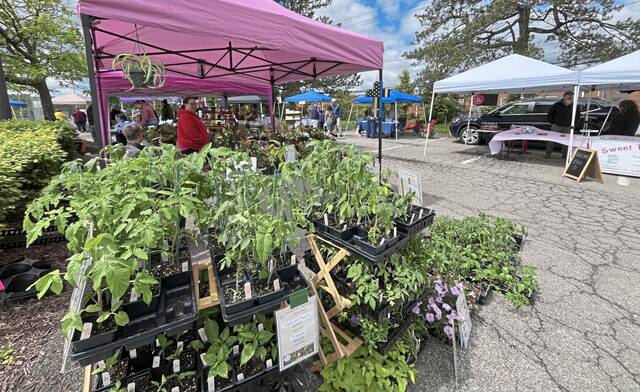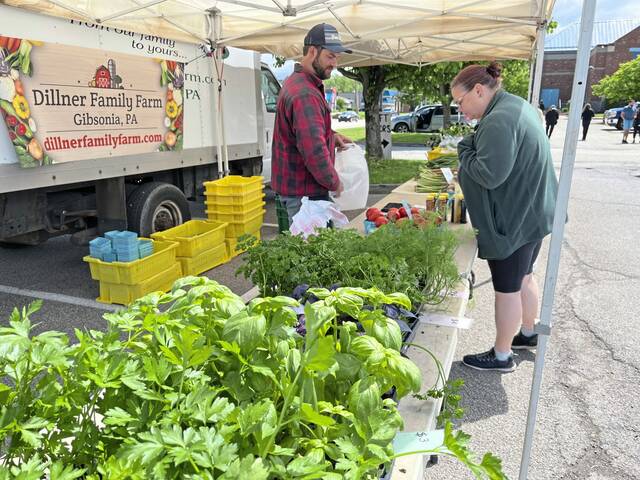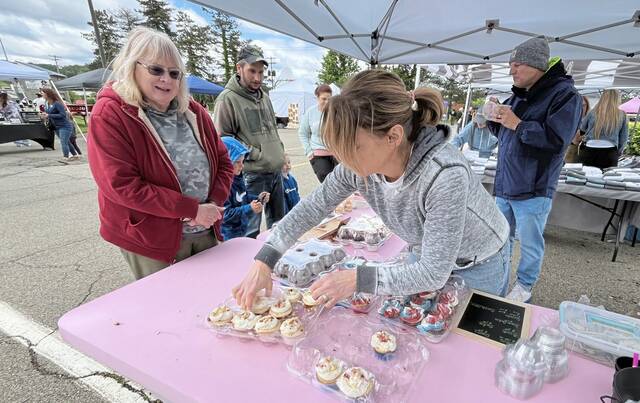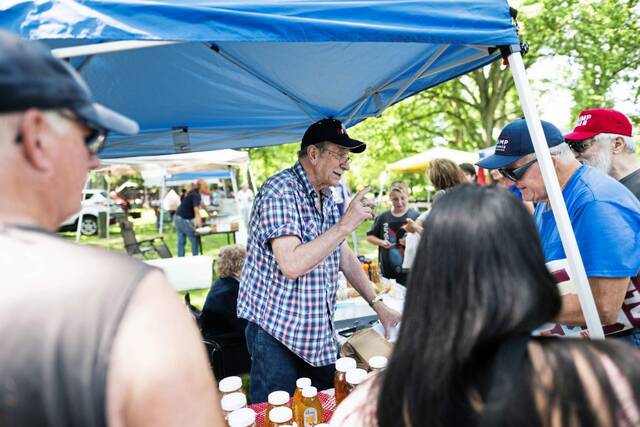The other side to farmers markets: A boost to local economies
Late spring and earlier summer are some of Jennifer Jackson’s favorite times of the year — the farmers markets are open.
“I wait all year long for this to open,” said Jackson of Brackenridge as she relaxed recently at Lower Burrell’s market. “I go to all of them.”
In addition to an apartment-warming gift for her son, Jackson picked up an assortment of foods, including meat, sausage, tomatoes and asparagus, and was considering getting some wine on the way out.
“It’s fun to support local businesses,” she said.
On top of providing high-nutrient, fresh food sources, farmers markets are feeding local economies in Pennsylvania to the tune of $200 million a year, according to studies.
One such study, conducted by the U.S. Department of Agriculture in 2020, showed Pennsylvania ranked second in the nation in direct-to-consumer farm sales at $600 million. California was first with about $1.4 billion.
Direct sales bypass third-party vendors like grocery stores and allow consumers to buy directly from the farmer — with community farmers markets making up about 14% of those sales, according to a 2022 study by the Penn State University Agricultural Extension Office.
In a study conducted by Penn State from December 2024 to March 2025, the Retail Farm Market Benchmark Project, estimated farmers markets pump about $203 million into state and local economies. The study describes that figure as conservative. In total, the state has about 330 farmers markets operating each year. That number jumps to 700 when roadside stands and retail stands located on farms are included.
A survey of vendors conducted as part of the study reported a 10% hike in sales at markets last year, compared to 2023 with a 14% increase in customers over the same time.
‘Bumps up your visibility’
Visitors to the Latrobe Farmers Market fill the 100-car parking lot of Legion Keener Park every Tuesday from June to October, said Craig Shevchik, Latrobe parks and recreation director.
Previously run by the Latrobe Community Revitalization Program, the market has been a staple in the city for more than 15 years.
“People look forward to coming down there on Tuesday — whether it’s to people-watch or to grab lunch or to grab some vegetables for the next few days or even get a graduation gift or a wedding gift,” Shevchik said.
The markets work, not just for farmers but other vendors as well.
Kathi Graczyk, a baker from Buffalo Township, was attending her first farmers market in Lower Burrell since starting her business, Bite-Sized Bliss, three months ago. After relying on word of mouth to move her cookies, cupcakes and other sweet treats, she came to the market to attract more business.
It worked.
“I’m almost sold out,” she said. “It really bumps up your visibility.”
The Latrobe Farmers Market draws between 25 and 30 vendors each week, selling handmade or hand-grown food, baked goods and crafts. They serve as a good networking opportunity for local business owners, said market Manager Kevin Hook.
“I know a lot of vendors go to different markets around the county,” he said. “But having connections in each little community helps them continue to grow their business.”
Kira Rogers, of Plum, was one of Graczyk’s customers, buying her chocolate chip biscotti. It was her first time coming to Lower Burrell’s market, where she enjoyed the arts and crafts, checking out the food trucks and shopping for handmade gifts.
“I just like to support the local vendors,” she said. “I like being able to walk around and I like being outside.”
Brian Moyer, educational program associate with the Lehigh County Penn State Extension office, conducted the benchmark project and the Farmers Market Assessment Survey in June and July of last year.
Survey demographic results showed the most frequent customers at farmers markets were those 51 and older, either visiting weekly or at least two to three times per month.
Customers 51 and older reported spending more than $41 during each visit, while those between the ages of 20 and 30 spent between $11 and $30.
Moyer predicts this year’s numbers will be similar. “Markets appear to have started strong this season,” he said.
Moyer hopes the data collected from the survey will prompt market organizers to begin thinking about how they can improve for future seasons.
“I think all too often markets aren’t asking the community who supports them what they want to buy,” Moyer said. “Are the people in our markets reflective of the community the market is located in?”
Nutritional boost
Lower Burrell market Manager Carley Logan called the city’s offering “invaluable,” for customers but also vendors.
“They connect people to foods that are more nutritious and things they may have never tried before,” she said. “They offer the food insecure an opportunity to get out and get fresh foods.”
Many of the vendors are “cottage vendors,” Logan said. “We’re a staple market that provides them income.”
New Kensington Mayor Tom Guzzo described his city’s farmers market, in its first year, as “a great opportunity for those who live downtown to have access to fresh, healthy and seasonal produce.”
Despite the city having several larger supermarkets, downtown is without one, creating a micro-food desert. The farmers market fills a gap of food insecurity and accessibility, Guzzo said.
Tarentum’s Farmers Market aims to do the same. The Rev. Philip Beck of First United Presbyterian Church said the church-run market provides accessible produce as a solution to the town’s “food desert” status.
“We think that local food, or fresh food, that comes directly from someone’s farm … it makes a difference,” Beck said.
Food deserts are a prominent concern in southwestern Pennsylvania neighborhoods.
Darlene Wolnik, with the Farmers Market Coalition, said a 2020 analysis of farmers markets and their role in reducing food insecurity in Southwestern Pennsylvania showed a need for farmers markets.
The analysis found that Pittsburgh has the largest percentage of people residing in communities with “low-supermarket access” (LSA). “Approximately 47%, or 145,245 Pittsburgh area residents, experience low access,” the report states. “In the metro area, including all of Allegheny County, 18% of residents, or 422,513 people, reside in LSA communities.”
Like Tarentum, communities such as Lower Burrell and Arnold are also considered food deserts.
Arnold Mayor Shannon Santucci is not aware of any plans for a farmers market in her town, though the New Kensington and Lower Burrell farmers markets are in close proximity.
“I am not opposed to a farmers market in Arnold,” Santucci said. “I would certainly welcome anybody who would want to make that happen.”
Moyer said produce at farmers markets are generally fresher, last longer and are more nutrient dense.
“Most farmers markets are picking the day before they go to market,” he said. “You can’t get it much fresher than that.”
Madison Stokes and Nadia Commodore are TribLive staff writers. Reach Madison at mstokes@triblive.com and Nadia at ncommodore@triblive.com.
Staff writers Quincey Reese and Brian C. Rittmeyer contributed.
Remove the ads from your TribLIVE reading experience but still support the journalists who create the content with TribLIVE Ad-Free.







